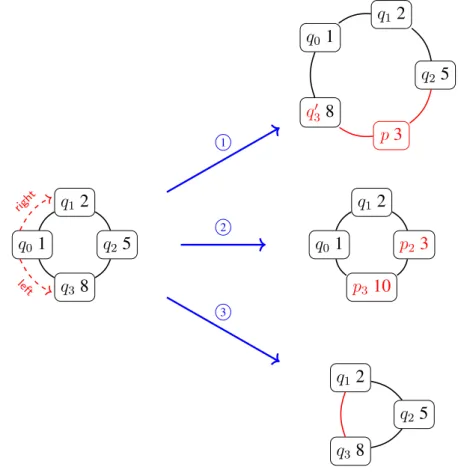Concurrency Theory(WS 2016) Out: Mon, 19 Dec Due: Wed, 04 Jan
Exercise Sheet 8
D’Osualdo, Lederer, Schneider Technische Universit¨at Kaiserslautern
Please submit your solutions before Wed, 04 Jan at 10am. E-mail submissions are encouraged.
F Prelude: Ring Systems f
We want to model a ring of processes, in which the processes can communicate with their left/right neighbours. Each process has a control state and budget to spend, i.e. a natural number which must remain non-negative at all times. Coins from the budget can be transferred to neighbours or received from neighbours. New processes can be created dynamically, and any process in the ring can fail at any point in time. We call this model of computation aring system.
More formally, a ring system is specified by an automaton(Q,∆)with finite control statesQ and transition relation∆⊆Q×Act ×Q. Let the set of directions beDir ={left,right}, then the setAct of actions is defined as below:
Act :={d!n |d∈Dir, n∈N}
∪ {d? |d∈Dir}
∪ {(q, n) @d |d ∈Dir, q ∈Q, n∈N}
Intuitively, an actiond!nmeans that the process is ready to transferncoins of its budget to its d-neighbour; an actiond?means that the process is ready to receive coins from thed-neighbour;
and executing an action(q, n) @dwill insert a new process on thedof the process executing the action, and this new process will have control stateqand initial budgetn. There is no transfer of budget during creation of a new process. Figure 1 should provide some illustration of the intended semantics.
Transfer of coins between two neighbours is synchronous. Let left:=rightand right :=left.
If a process has control stateq1with(q1, d1!n, q10)and budget greater or equal thann, and its d1-neighbour has control stateq2 with(q2, d2?, q02)and d2 = ¯d1, then they can execute both transitions at the same time and transferncoins from one process the other.
At any point in time a processes can fail. When a process fails in one step the ring ofkprocesses becomes a ring ofk−1processes. The two neighbours of the failed process become neighbours to each other.
The goal is to define an algorithm to verify if a ring containing a process with control stateqand budget greater thanB can be reached from a given initial ring. We will achieve this by reducing the problem to coverability of a WSTS and instantiating the Backwards and the Forwards Search algorithms.
F
Problem 1: Backwards Search on ring processes
a) Formalize the configuration spaceSand the semantics→ ⊆S×Sof the model.
[Hint:A ring of arbitrary size is almost a word]
b) Define an orderEover configurations. Prove that(S,→,E)is an effective WSTS and argue why the problem above reduces to coverability.
c) Give an algorithm to compute minpre for ring processes.
Problem 2: Forwards Search for ring processes
a) DescribeIdeals(S)for the configuration spaceSof problem 1, as a recursively enumerable set.
b) Argue whether inclusion between ideals ofS is decidable.
c) Show how to computepostd for transitions executing(q, n) @d.
OPTIONAL:Consider also the process of transferring coins.
[Hint:Use the definition ofpostd for LCS as source of ideas]
Problem 3: Ideals
a) Show thatL(r)is downward closed for everyr ∈SRE(Σ)whereΣis a finite alphabet.
(This completes the proof seen in class that the downward closed languages are exactly the simple regular languages)
b) Prove that the products overΣare exactly the ideals ofΣ∗.
[Hint:Use the fact thatSREare exactly the downward closed subsets ofΣ∗]
c) OPTIONAL: Let (S,≤) be a wqo with effective ideal completion (i.e. Ideals(S) is recursively enumerable and inclusion between ideals is decidable). Show inclusion of SRE(S)languages is decidable, by extending the algorithm seen for inclusion of products for simple regular languages over finite alphabets.
[Hint:This may be useful for solving problem 2b]
Problem 4: Forward Uncoverability for LCS
Consider the following LCS with a single channelcand messagesM ={a, b, c}:
q0 c!a q1 c!b q2
c?a
c!c
Prove unreachability ofγ = (q0,c7→bb)by defining a downward closed set of configurationsD, represented as a finite union of ideals, such thatD⊇post(D)d and(q0,ε)∈D, butγ 6∈D.
Figure 1: The picture shows a ring of processes on the left and three possible transitions.
q25 q1 2
q0 1
q3 8
left right
p23 q12
q0 1
p310
q2 5 q1 2 q0 1
q30 8
p3
q2 5 q1 2
q3 8 1
2
3
The changes introduced by the transitions are highlighted in red in the three resulting rings.
The three transitions are justified as follows:
1 (q3,(p,3) @left, q30)∈∆
2 (q2,right! 2, p2),(q3,left?, p3)∈∆ 3 the process with control stateq0 fails
